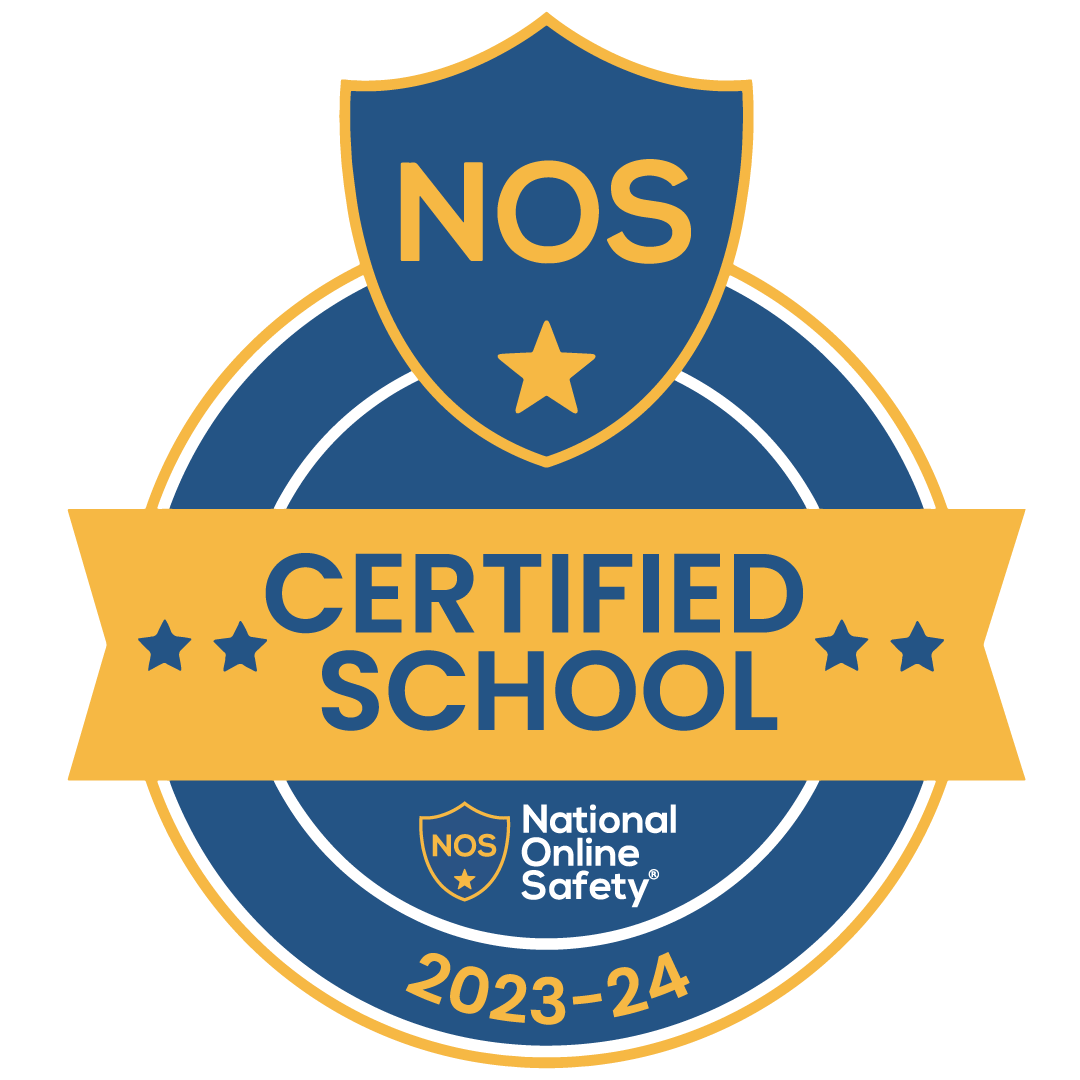Design Technology
Department Staffing & Roles
- Mrs A Sturgess – Head of Design Technology / Teacher of Design Technology & 3D Design & Graphic Design
- Miss C Baker – Teacher of Design Technology & Art
- Miss H Bridge – Teacher of Design Technology / Head of Art
- Miss L Davies – Teacher of Design Technology & ICT
- Mr P Greathead – Teacher of Design Technology & Engineering
- Miss F McDowell – Teacher of Design Technology & Hospitality & Catering / Head of Malala House / Designated Safeguarding Lead
- Mrs H Parker – Teacher of Design Technology & Hospitality & Catering
- Mrs H Shard– Teacher of Design Technology & Engineering & Child Development / BTEC Quality Nominee / Head of Year 8
- Miss S Skellington – Teacher of Design Technology & Hair & Beauty & Dance
- Mr D Northedge – Design Technology Technician
- Mrs A Hodson – Design Technology Technician
Vision: We will make the biggest difference to the lives of all our students by laying the foundations to encourage a successful future.
Design & Technology is a dynamic and practical subject that empowers students to become creative problem-solvers, critical thinkers, and innovators. Through hands-on experiences and exposure to real-world challenges, students develop technical knowledge, design skills, and resilience—preparing them for a rapidly changing world.
Subject Intent
‘The department aims to enrich all learners through its curriculum to provide students with access to the experiences and skills necessary to equip them for life.’
Our intent is to:
- Develop Creativity and Innovation: Encourage students to design and make products that solve real problems, considering user needs, functionality, and sustainability.
- Build Technical Competence: Provide opportunities to master practical skills across materials, electronics, CAD/CAM, and emerging technologies.
- Promote Critical Thinking: Foster analytical skills through research, evaluation, and iterative design processes.
- Prepare for the Future: Equip students with transferable skills—communication, teamwork, and adaptability—that support success in further education, careers, and life.
- Celebrate Diversity and Inclusion: Ensure all learners have equal access to resources, experiences, and pathways to achievement.
Designers and technologists work in almost every area of life; from food & nutrition, textile design, product design, graphic design, interior design, engineering design and environmental design. Each area requires a different skillset, but they all involve a similar design process.
Key Stage 3
In Key Stage 3 we follow the National Curriculum for Design and Technology.
At key stage 3 all students study Design and Technology on a rotation system. The focus of each area is predominantly on practical work, teaching students the practical skills they need to be able to produce a wide range of products. In addition to the practical skills, students are taught key knowledge and skills. Numeracy and literacy play a key part in the delivery of the DT curriculum.
The scheme of learning progresses from making items for themselves onto making items for others and then specific clients and groups in society.
KS3 Food Technology – Curriculum

KS3 Food provides students with essential knowledge and practical skills to make informed choices about diet, nutrition, and food preparation. It encourages creativity, independence, and an understanding of the impact of food on health and the environment.
Key Aims:
- Healthy Eating: Teach the principles of nutrition and the Eatwell Guide to promote balanced diets.
- Practical Skills: Develop confidence in preparing and cooking a variety of dishes safely and hygienically.
- Food Science: Explore how ingredients behave and interact during cooking processes.
- Cultural Awareness: Introduce global cuisines and the role of food in different cultures.
- Sustainability: Highlight issues such as food waste, seasonality, and ethical choices.
Skills Developed:
- Knife skills and safe use of equipment
- Cooking methods (baking, boiling, frying, grilling)
- Time management and organisation
- Evaluating and adapting recipes
Progression:
Students build from foundation skills in Year 7 to more complex dishes and emerging techniques in Year 9, preparing them for WJEC Hospitality & Catering.
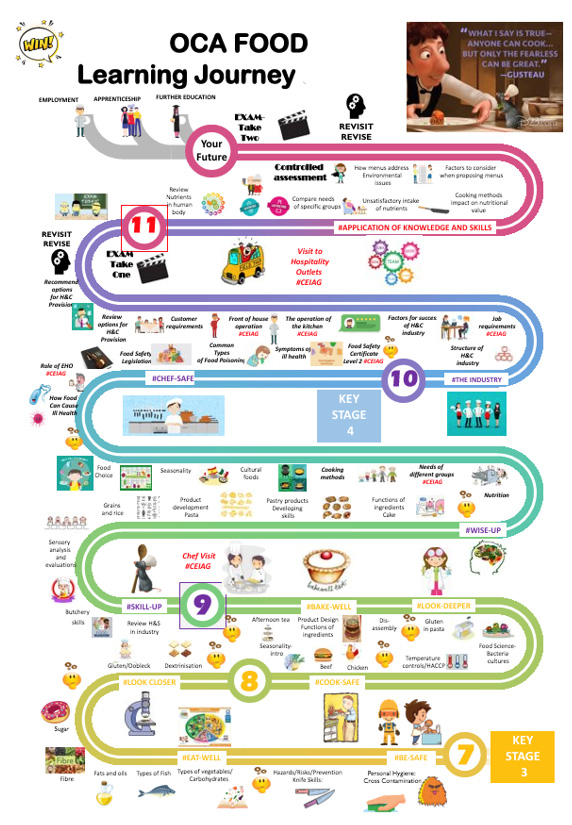
KS3 3D Design – Curriculum
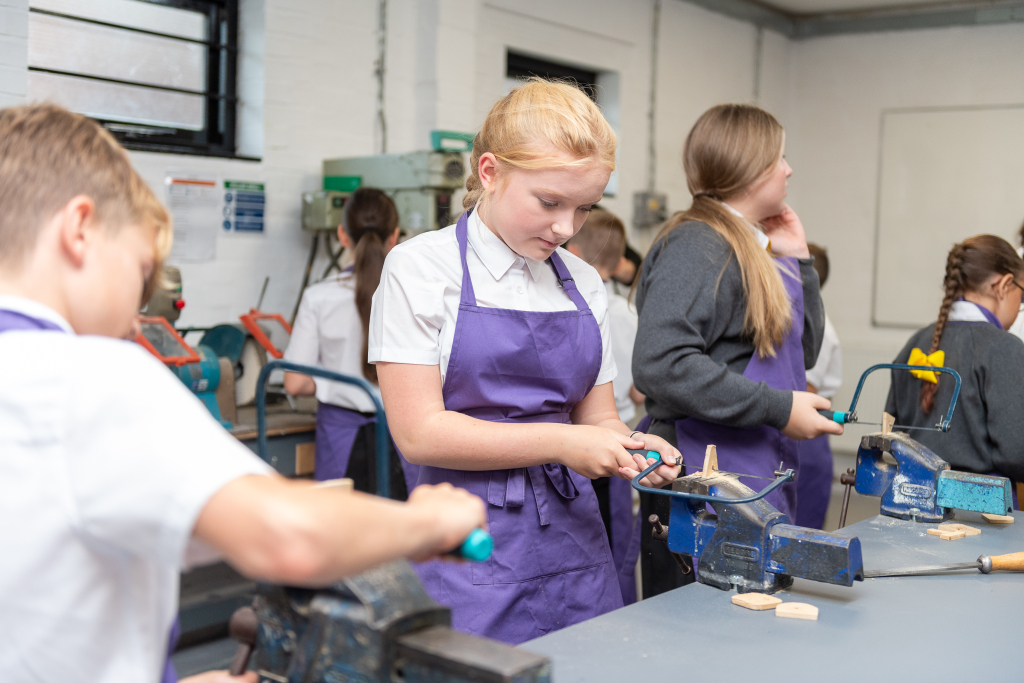
KS3 3D Design introduces students to the principles of designing and creating three-dimensional products using a range of materials and techniques. It develops creativity, problem-solving, and technical skills while encouraging students to think about functionality, aesthetics, and sustainability.
Key Aims:
- Design Thinking: Teach students how to research, generate ideas, and develop design concepts for 3D products.
- Material Knowledge: Explore properties and uses of materials such as wood, metal, plastics, and mixed media.
- Practical Skills: Develop competence in hand tools, machinery, and digital technologies (CAD/CAM).
- Sustainability & Ethics: Promote awareness of environmental impact, recycling, and responsible design choices.
- Critical Evaluation: Encourage students to analyse and refine their work through iterative design processes.
Skills Developed:
- Sketching and visual communication
- Model making and prototyping
- Safe use of tools and equipment
- CAD software for 3D modelling
- Joining, shaping, and finishing techniques
Progression:
Students begin with foundation design principles and projects in Year 7, moving towards more complex, functional products and digital integration by Year 9. This prepares them for Art & Design (3D Design) and/or Engineering.
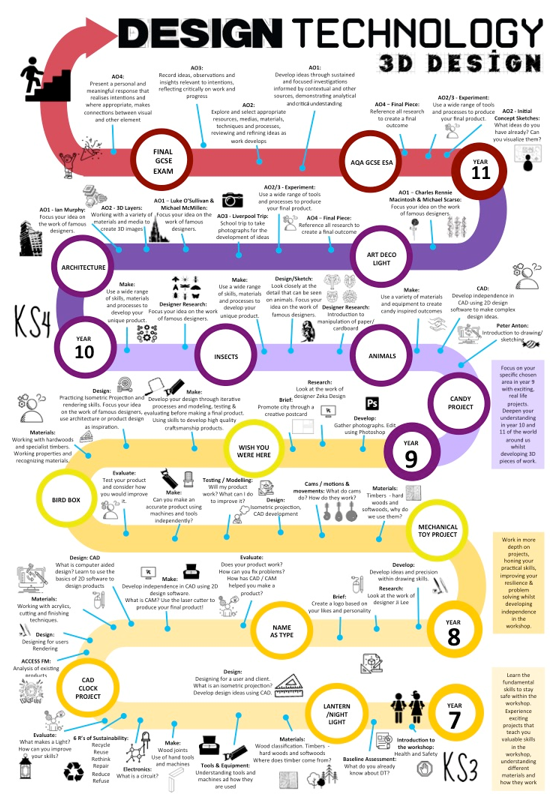
KS3 Graphic Design – Curriculum
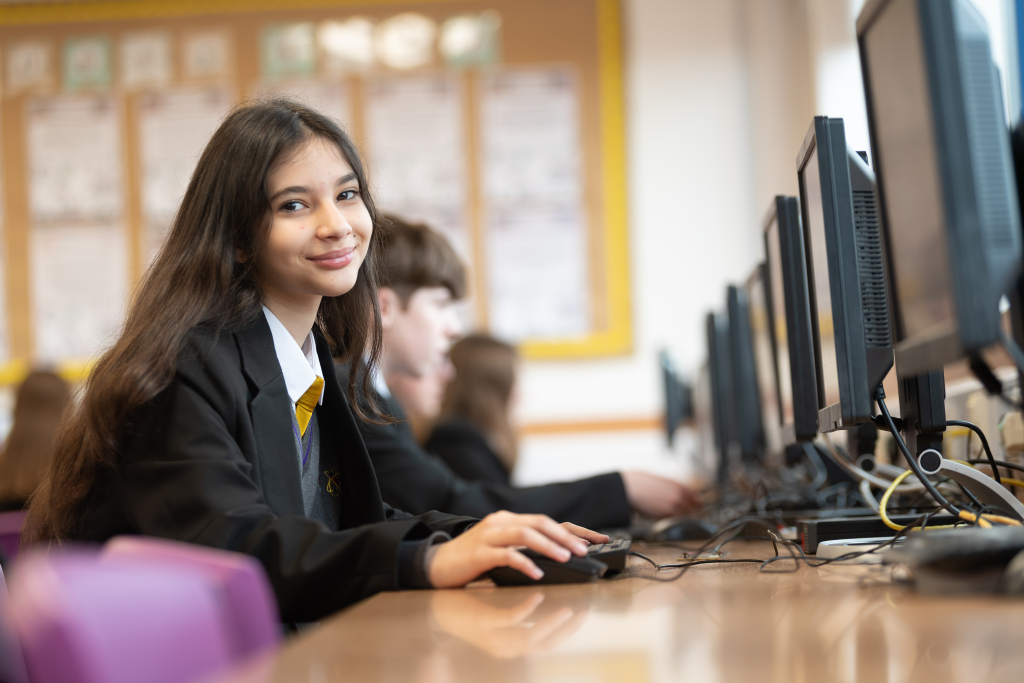
KS3 Graphics introduces students to visual communication and creative problem-solving through design. It focuses on developing skills in presenting ideas effectively using both traditional and digital media, preparing students for careers in design, advertising, and creative industries.
Key Aims:
- Design Communication: Teach students how to convey ideas visually through sketching, rendering, and layout.
- Digital Skills: Develop competence in industry-standard software such as Photoshop, Illustrator, and CAD tools.
- Creative Thinking: Encourage innovative approaches to branding, packaging, and promotional design.
- Typography & Composition: Explore the principles of layout, color theory, and font selection for effective communication.
- Sustainability & Ethics: Promote awareness of responsible design practices and environmental impact in graphics production.
Skills Developed:
- Hand-drawn sketching and presentation techniques
- Digital image manipulation and vector graphics
- Understanding of design briefs and target audiences
- Use of colour, typography, and composition principles
- Critical evaluation and iterative design
Progression:
Students start with foundation visual communication and design tasks in Year 7, moving towards more complex projects involving branding, packaging, and digital media by Year 9. This provides a strong foundation for GCSE Art & Design (Graphics).
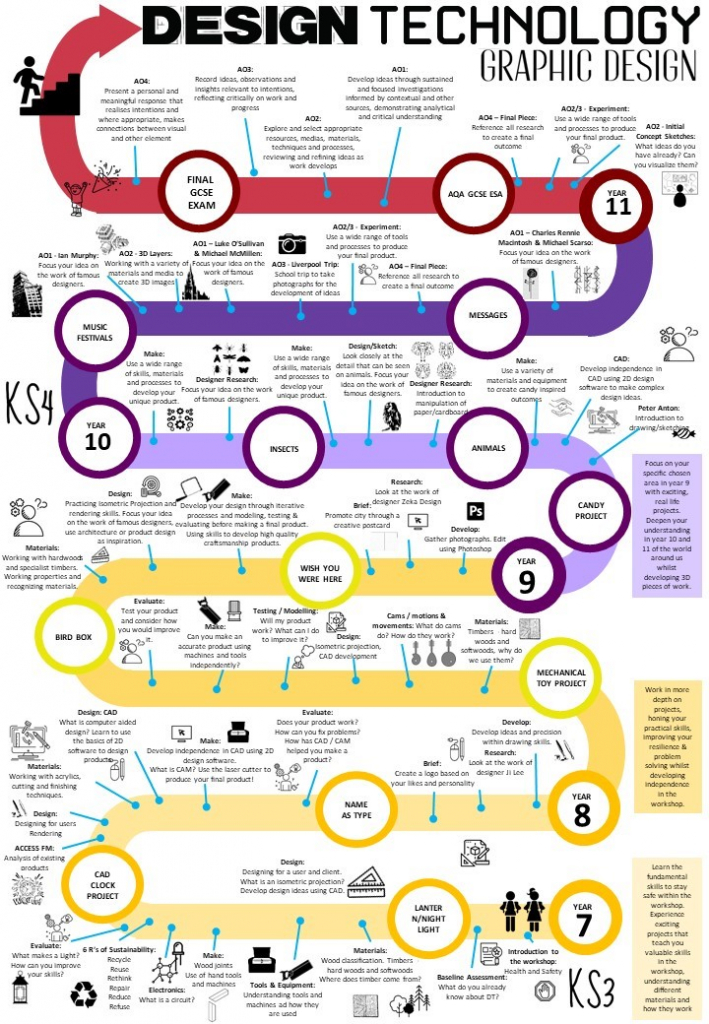
KS3 Engineering – Curriculum
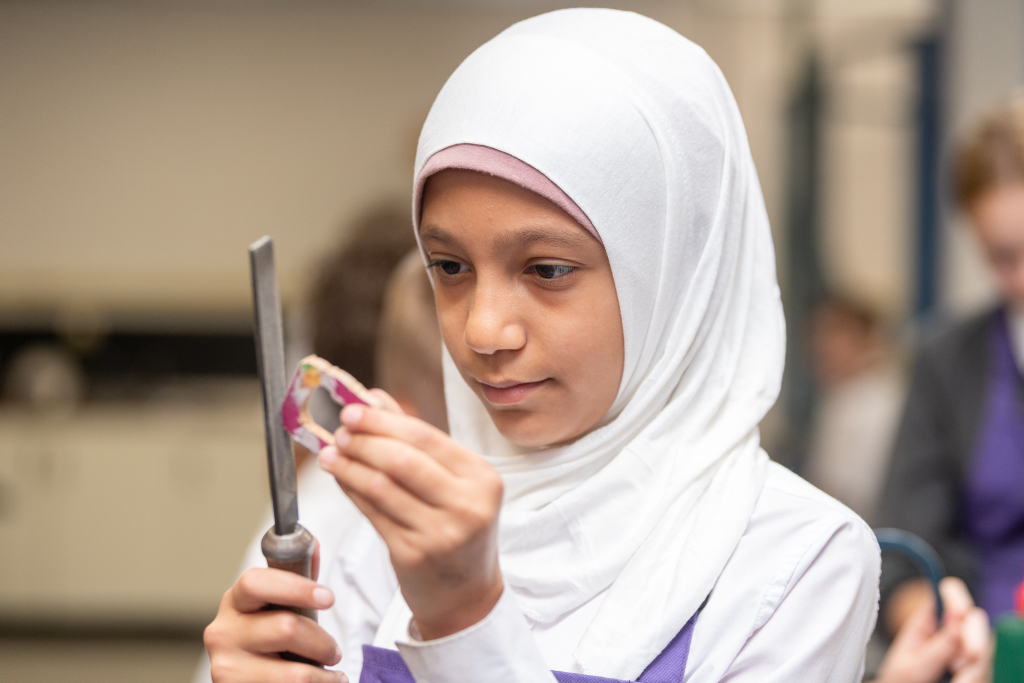
KS3 Engineering introduces students to the principles of designing, making, and understanding engineered products and systems. It focuses on problem-solving, technical knowledge, and practical skills that prepare learners for modern industry and future careers.
Key Aims:
- Engineering Principles: Develop understanding of forces, mechanisms, materials, and manufacturing processes.
- Design & Innovation: Encourage creative solutions to real-world problems using iterative design processes.
- Practical Skills: Build competence in using tools, machinery, and digital technologies (CAD/CAM).
- STEM Integration: Apply science, technology, and mathematics in practical engineering contexts.
- Sustainability & Ethics: Promote responsible design choices considering environmental and social impact.
Skills Developed:
- Technical drawing and CAD modelling
- Safe use of workshop tools and equipment
- Understanding mechanical systems and structures
- Problem-solving and project planning
- Testing and evaluating prototypes
Progression:
Students are introduced to Engineering in Year 9 drawing knowledge from Year 7 and 3D Design lessons moving towards more complex systems and manufacturing techniques by Year 9. This provides a strong foundation for WJEC Engineering
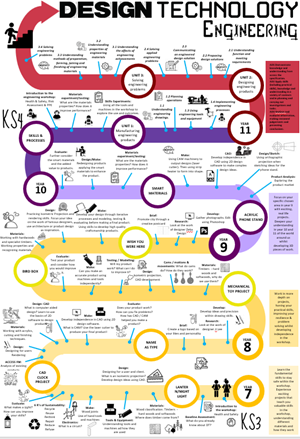
Key Stage 4 Options
Our curriculum in years 10 and 11 reflects the interests of students. .
Below are the courses we currently deliver within the Department with a link to the exam specification.
3D Design
The GCSE specification for the course can be found here
Student’s work will be Assessed through two Components.
In Component 1 (Coursework 60%) students will research and investigate sources of ideas in Art, Craft & Design. They will explore and use Art, Craft & Design material and techniques to develop visual language. Students will complete a portfolio or sketchbook demonstrating their creative journey. This should be evidence of the process of developing both ideas and work. It should demonstrate research, supporting studies and work, showing the development of their ideas, leading to finished pieces.
Structures – During this project pupils will explore the work of Wyndham Lewis and Denys Lasdun. Students will have the opportunity to visit Liverpool to allow them to gather photographs that will aid their development. With these photographs, students will experiment, explore and develop a variety of responses in 2D and 3D. All experiments will lead to a final 3D outcome.
Art Deco light – Students will respond to a brief for a Art Deco light, looking at the movement Art Deco and the work of Charles Rennie Mackintosh. Students will then research, develop and refine in a variety of materials, media and techniques before creating their final outcome.
In Component 2 (Exam 40%), the exam board provides students with a theme for their exam. Students are given a number of weeks to develop ideas and prepare. Students sit a 10-hour exam in Year 11 in which they produce their final outcome.
Graphic Design
The GCSE specification for the course can be found here
Students work will be assessed through two Components.
In Component 1 (Coursework 60%) students will research and investigate sources of ideas in Art, Craft & Design. They will explore and use Art, Craft & Design material and techniques to develop visual language. Students will complete a portfolio or sketchbook demonstrating their creative journey. This should be evidence of the process of developing both ideas and work. It should demonstrate research, supporting studies and work, showing the development of their ideas, leading to finished pieces.
Music Festivals – Students will be set a brief from a Music Festival company to create the branding for an up and coming Festival in Liverpool in the summer. Students will take photographs that relate to the project and then develop their brand promotion through logo design, poster and merchandise.
Messages – Students will select their own message to promote; for example, road safety or stay safe online. Students will then gather their own photography before experimenting with materials, Photoshop and media
In Component 2 (Exam 40%), the exam board provides students with a theme for their exam. Students are given a number of weeks to develop ideas and prepare. Students sit a 10-hour exam in Year 11 in which they produce their final outcome.
Child Development
The course specification for the course can be found here
Year 10
Component 1, students will gain knowledge of the principles of growth and development, including expected development milestones, for different age ranges across all five areas of development; physical, intellectual and cognitive, communication and language, social and emotional. Students will explore how different factors can positively or negatively impact different areas of a child’s expected development.
In Component 2, students will explore different stages and types of play and how play activities can support and promote children’s development and learning across the five areas of development between the ages of birth and five years old. Students will investigate the different learning needs of children at different ages and stages and learn how to plan and structure play activities to meet those learning needs and encourage and influence learning, while considering the role of adults in promoting children’s learning and development through play both at home and in the community.
Year 11
In Component 3, students will develop an understanding of how children’s learning and development can be affected by their individual circumstances. Students will investigate the importance of inclusion and the role of an adult in keeping children safe when engaging in play activities and how the environment and play activities can be adapted to support the learning and development of all children.
Engineering
The course specification for the course can be found here
Unit 1 provides learners with the opportunity to interpret different types of engineering information in order to plan how to manufacture engineering products. Learners will develop knowledge, understanding and skills in using a range of engineering tools and equipment in order to manufacture and test an end product
Year 11
Hospitality and Catering
The course specification for the course can be found here
Students undertake the WEJC Technical award in Hospitality and Catering. The course consists of 2 units. Unit 1 The Hospitality and catering industry and unit 2 Hospitality and catering in action.
During year 10 unit one is taught with a written external examination take in June. This unit allows students to understand how the industry and provisions operate, how the industry meets health and safety requirements and know how food can cause ill health.
Unit 2 is completed during year 11 and looks at nutrition and planning meals, menu planning and practical skills. This unit is assessed through a controlled assessment / NEA set by the exam board. Students also have another chance to retake the unit 1 external examination in the June of year
Design & Technology provides a foundation for a wide range of careers in creative, technical, and engineering sectors. The subject develops transferable skills such as problem-solving, communication, teamwork, and project management, which are highly valued by employers.
- Ensure the Gatsby benchmark is implemented across all year groups and all students have access to high quality careers opportunities, advice and guidance. The Gatsby Benchmark will be embedded into the curriculum throughout all year groups.
- Career checkpoints in lessons.
- Offer careers advice for pupils during the options process to guide/support in decision making
- Design Technology provides enrichment activities and clubs.
- Intervention sessions are tailored for all age and year groups.
- Maintain our Design Technology careers board giving a wide range of career opportunities and the qualifications required
Key Career Pathways:
- Engineering & Manufacturing: Mechanical, electrical, civil, and aerospace engineering roles.
- Product & Industrial Design: Designing consumer products, furniture, and innovative solutions.
- Architecture & Construction: Careers in building design, structural engineering, and project planning.
- Graphic & Digital Design: CAD specialists, UX/UI designers, and digital product developers.
- Food Industry: Nutritionists, chefs, food technologists, and hospitality management.
- Automotive & Transport Design: Vehicle design, aerodynamics, and sustainable transport solutions.
- Fashion & Textiles: Clothing design, sustainable fashion, and material innovation.
- Technology & Robotics: Careers in automation, AI integration, and smart product development.
Transferable Skills for Any Career:
- Creative thinking and innovation
- Technical competence and digital literacy
- Research and analytical skills
- Time management and organisation
- Communication and presentation skill
Links to Further Education:
- GCSE Design & Technology, Engineering, Food Preparation & Nutrition
- A-level Product Design, Engineering, Art & Design
- Apprenticeships in manufacturing, construction, and design
- University degrees in engineering, architecture, industrial design,.
Enrichment
The technology department has an enrichment platform that all students can get involved in. The program includes:
- CAD Club – Develop your skills with tools and machines within product design/3D Design whilst making fun and creative products
- Year 7 & 8 cooking club – practice your skills and make fun foods
- Workshops – chances inside and outside of school to enhance and develop industry skills with specialist e.g. chefs, therapists or engineers
- Industry Trips – students go to a variety of industry exhibitions and shows as part of their studies.
Intervention
Year 11 follow a whole school intervention timetable, however the Design Technology department additionally offer:
- 3D Design & Graphic design – Monday & Tuesday 3–4pm
The following resources are useful for Design Technology students:
Covers course with cartoons and quizzes
https://www.bbc.co.uk/bitesize/subjects/zbtvxyc
Flash cards
https://www.cram.com/search?query=Hospitality+and+catering&submit=Search
The exam boards knowledge organisers
https://resources.wjec.co.uk/pages/ResourceSingle.aspx?rIid=4864
Questions and definitions
https://app.memrise.com/dashboard
- Technology Student – Technology Student
- BBC Bitesize – BBC Bitesize – Design and Technology
- Tate gallery online tate.org.uk/kids
- British Museum https://britishmuseum.withgoogle.com/
- Tasty careers – https://tastycareers.org.uk/
Design & Technology learning doesn’t stop at the classroom door—it extends into real-world experiences that inspire creativity, innovation, and career readiness. These opportunities allow students to apply their skills in authentic contexts, deepen their understanding, and connect with industry professionals
Why It Matters:
Builds confidence and independence through hands-on experiences. Strengthens links between classroom learning and future careers. Encourages teamwork, problem-solving, and resilience in new environments.
Competitions & Challenges
- Design Ventura (by the Design Museum) – real-world design briefs for students.
- F1 in Schools – STEM-based engineering and design challenge.
- Young Engineer of the Year Awards – promotes innovation and problem-solving.
- Rotary Technology Tournament – teamwork and practical problem-solving.
Educational Visits
- Design Museums & Galleries
- Manufacturing Plants & Factories – insight into industrial processes.
Industry Links & Guest Speakers
- Invite professionals from engineering, product design, architecture, or food industries.
- Virtual talks from universities or apprenticeships providers.
Workshops & Clubs
- After-school D&T Clubs – CAD/CAM projects, robotics, or 3D printing.
- Maker Spaces – collaborative projects using advanced tools and tech.
Community Projects
- Design solutions for local charities or community needs.
- Sustainable design initiatives (e.g., upcycling projects).
Career & Apprenticeship Events
- Visits to local colleges and universities for taster sessions.
- Links with employers for work experience or shadowing.


